After the transfer of DDR3 IP core, is not directly read and write tests, you must first perform an initialization operation, check IP core. Benpian using Modelsim software with the simulation model DDR3 IP core generation, build the initialization process IP core.
A top-level documents
1, after generation DDR3 IP core, right-click on the Source screen blank Add Source, add a top-level file.
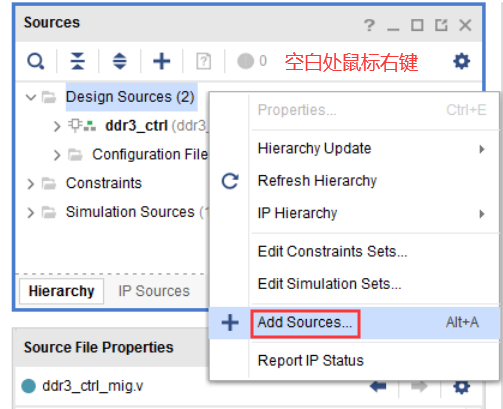
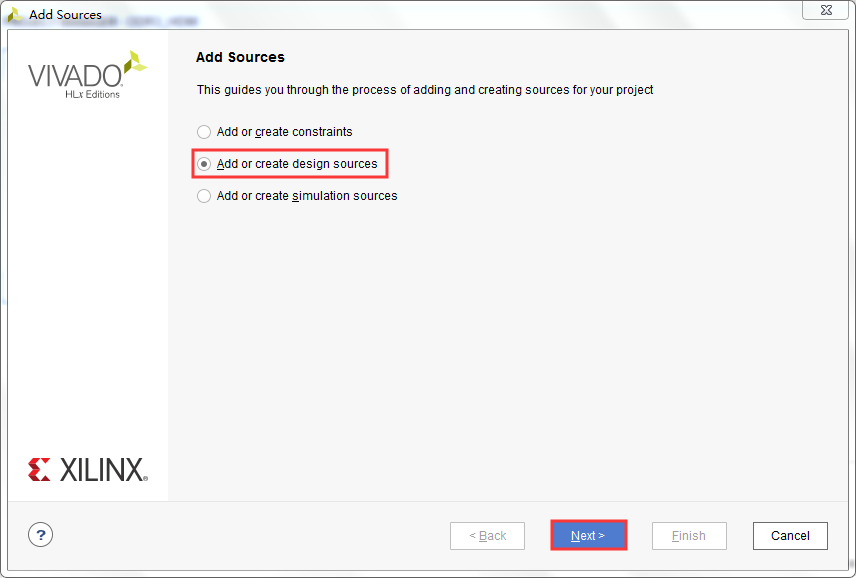

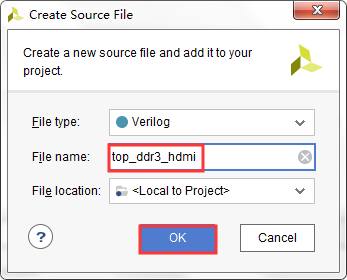
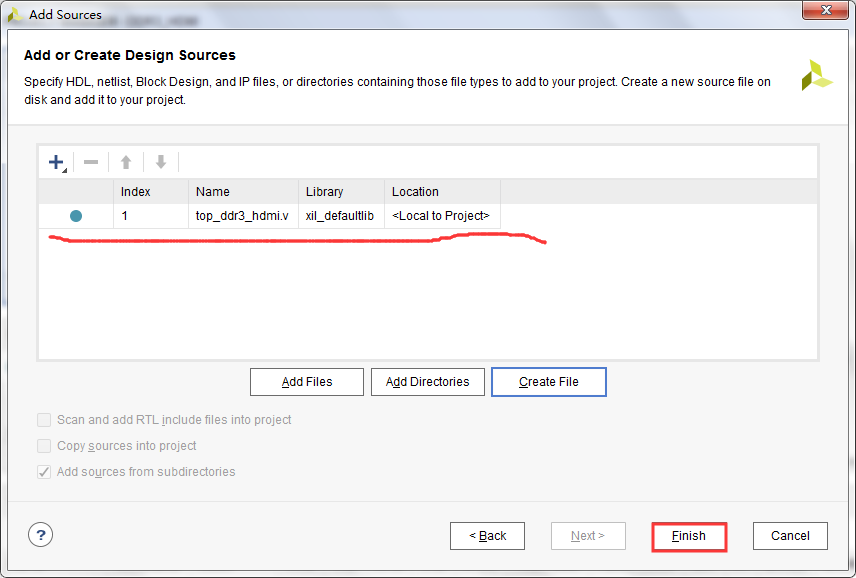
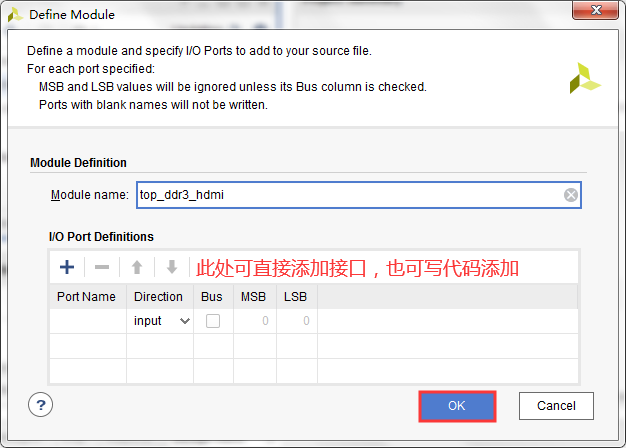

2, the DDR3_HDMI \ DDR3_HDMI.srcs \ sources_1 \ ip \ ddr3_ctrl \ ddr3_ctrl \ user_design \ rtl \ ddr3_ctrl.v available input and output ports top_ddr3_hdmi need to copy it over.
1 module top_ddr3_hdmi 2 //========================< 端口 >========================================== 3 ( 4 // inout ---------------------------------------- 5 inout wire [15:0] ddr3_dq , 6 inout wire [ 1:0] ddr3_dqs_n , 7 inout wire [ 1:0] ddr3_dqs_p , 8 // output --------------------------------------- 9 output wire [13:0] ddr3_addr , 10 output wire [ 2:0] ddr3_ba , 11 output wire ddr3_ras_n , 12 output wire ddr3_cas_n , 13 output wire ddr3_we_n , 14 output wire ddr3_reset_n , 15 output wire [ 0:0] ddr3_ck_p , 16 output wire [ 0:0] ddr3_ck_n , 17 output wire [ 0:0] ddr3_cke , 18 output wire [ 0:0] ddr3_cs_n , 19 output wire [ 1:0] ddr3_dm , 20 output wire [ 0:0] ddr3_odt , 21 // system --------------------------------------- 22 input wire sclkin , 23 input wire srst_n 24 );
3, the top-level module to write, you can enter the IP Source of ddr3_ctrl.veo found files copied example of the interface, and change the part of the signal according to demand.
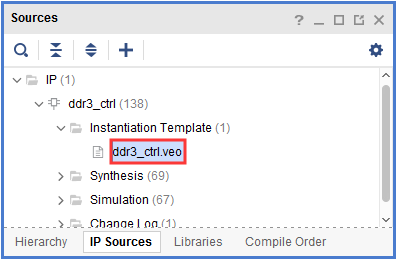

1 ddr3_ctrl u_ddr3_ctrl 2 ( 3 // Memory interface ports ----------------------- 4 .ddr3_addr (ddr3_addr ), // output [13:0] ddr3_addr 5 .ddr3_ba (ddr3_ba ), // output [2:0] ddr3_ba 6 .ddr3_cas_n (ddr3_cas_n ), // output ddr3_cas_n 7 .ddr3_ck_n (ddr3_ck_n ), // output [0:0] ddr3_ck_n 8 .ddr3_ck_p (ddr3_ck_p ), // output [0:0] ddr3_ck_p 9 .ddr3_cke (ddr3_cke ), // output [0:0] ddr3_cke 10 .ddr3_ras_n (ddr3_ras_n ), // output ddr3_ras_n 11 .ddr3_reset_n (ddr3_reset_n ), // output ddr3_reset_n 12 .ddr3_we_n (ddr3_we_n ), // output ddr3_we_n 13 .ddr3_dq (ddr3_dq ), // inout [15:0] ddr3_dq 14 .ddr3_dqs_n (ddr3_dqs_n ), // inout [1:0] ddr3_dqs_n 15 .ddr3_dqs_p (ddr3_dqs_p ), // inout [1:0] ddr3_dqs_p 16 .init_calib_complete (init_calib_complete ), // output init_calib_complete 17 .ddr3_cs_n (ddr3_cs_n ), // output [0:0] ddr3_cs_n 18 .ddr3_dm (ddr3_dm ), // output [1:0] ddr3_dm 19 .ddr3_odt (ddr3_odt ), // output [0:0] ddr3_odt 20 // Application interface ports ------------------ 21 .app_addr (app_addr ), // input [27:0] app_addr 22 .app_cmd (app_cmd ), // input [2:0] app_cmd 23 .app_en (1'b0 ), // input app_en 24 .app_wdf_data (app_wdf_data ), // input [127:0] app_wdf_data 25 .app_wdf_end (1'b0 ), // input app_wdf_end 26 .app_wdf_wren (1'b0 ), // input app_wdf_wren 27 .app_rd_data (app_rd_data ), // output [127:0] app_rd_data 28 .app_rd_data_end (app_rd_data_end ), // output app_rd_data_end 29 .app_rd_data_valid (app_rd_data_valid ), // output app_rd_data_valid 30 .app_rdy (app_rdy ), // output app_rdy 31 .app_wdf_rdy (app_wdf_rdy ), // output app_wdf_rdy 32 .app_sr_req (1'b0 ), // input app_sr_req 33 .app_ref_req (1'b0 ), // input app_ref_req 34 .app_zq_req (1'b0 ), // input app_zq_req 35 .app_sr_active (app_sr_active ), // output app_sr_active 36 .app_ref_ack (app_ref_ack ), // output app_ref_ack 37 .app_zq_ack (app_zq_ack ), // output app_zq_ack 38 .ui_clk (ui_clk ), // output ui_clk 39 .ui_clk_sync_rst (ui_clk_sync_rst ), // output ui_clk_sync_rst 40 .app_wdf_mask (app_wdf_mask ), // input [15:0] app_wdf_mask 41 // System Clock Ports --------------------------- 42 .sys_clk_i (sysclk ), // input sys_clk_i 200Mhz 43 .sys_rst (srst_n ) // input sys_rst 44 );
4, when the transfer of DDR3 IP core, IP core selected for this input a 200 Mhz clock, since the board 50Mhz crystal clock is generated, so have to use one IP core 200 Mhz clock birth.
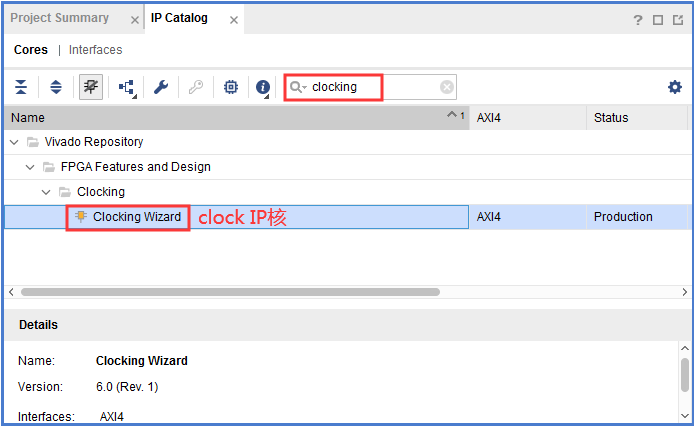
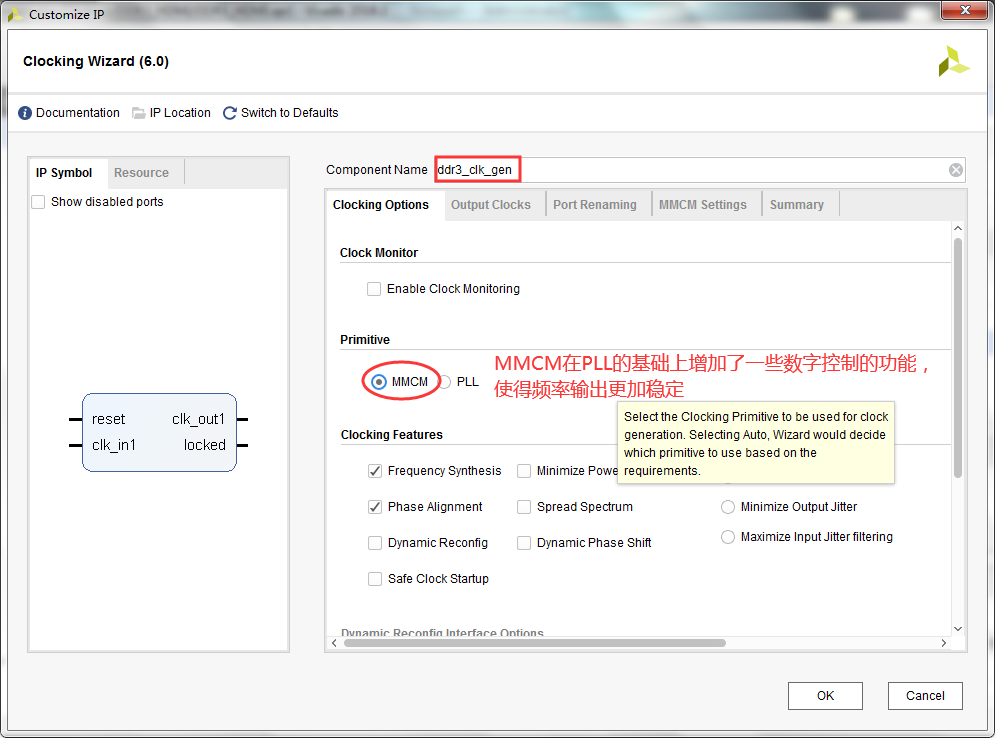

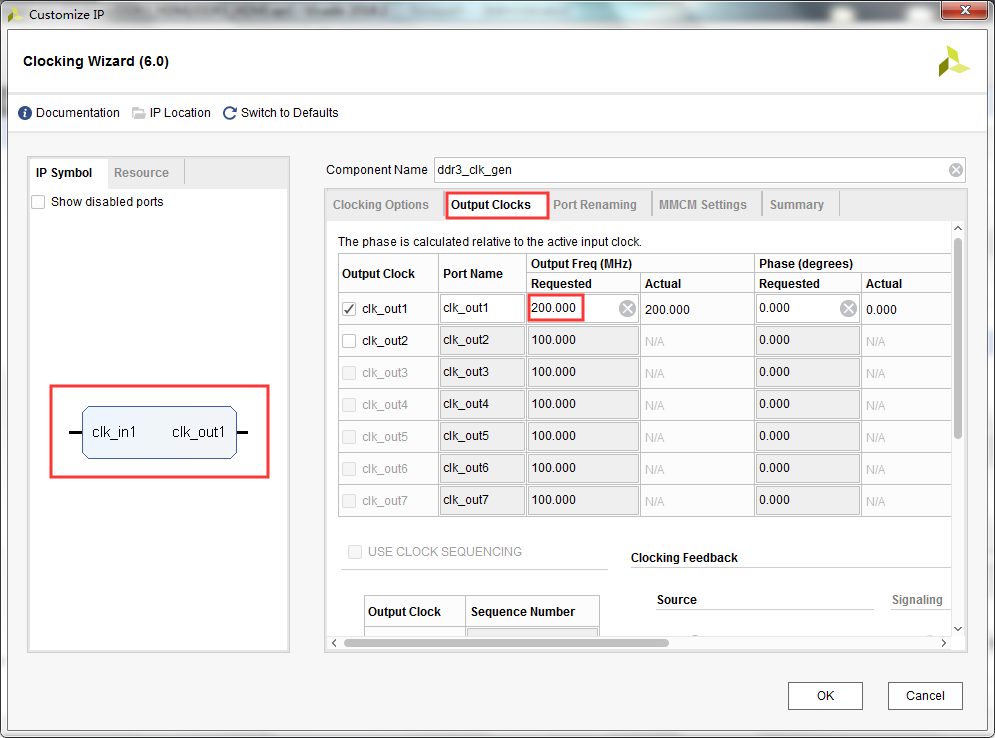
5, after generating the same clock to find .veo embodiment of the copied file interface.


1 ddr3_clk_gen u_ddr3_clk_gen 2 ( 3 .clk_out1 (sysclk ), // output clk_out1 4 .clk_in1 (sclkin ) // input clk_in1 5 );
7, there are a few signals that we need to observe, by wire leads come.
1 //========================< 连线 >========================================== 2 wire sysclk ; 3 wire init_calib_complete ; 4 wire ui_clk ; 5 wire ui_clk_sync_rst ;
Second, the test file
1, select Add Sources in the Simulation Sources Right, create testbench file.


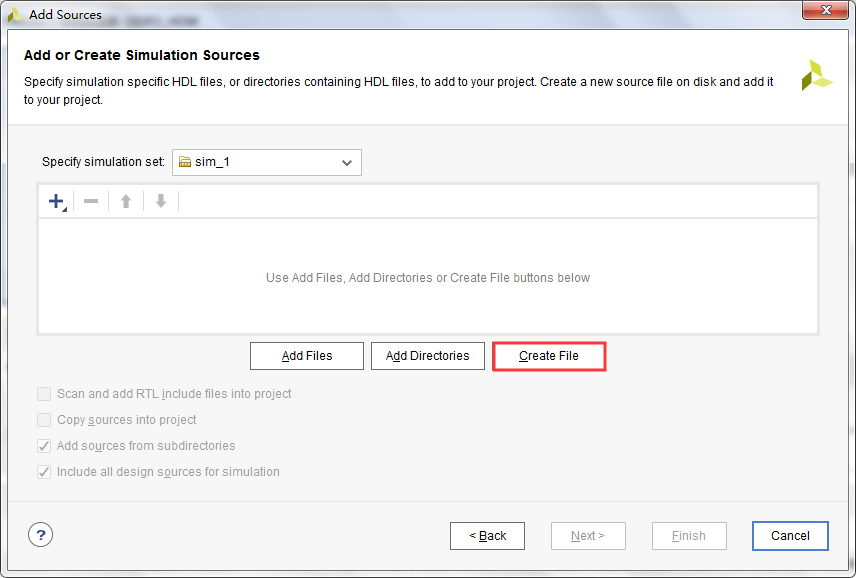
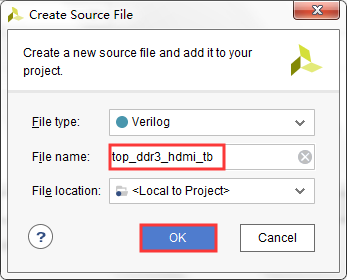

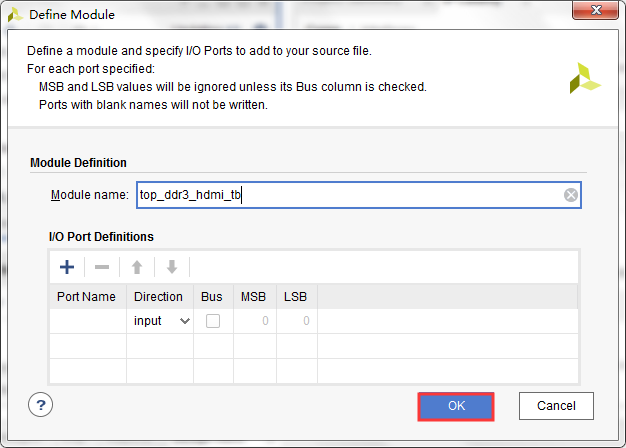

2, DDR3 controller is very complex, handwriting testbench is very difficult. When we talk about the transfer of a DDR3 IP core have said, it has generated a simulation model for us to test. Position in DDR3_HDMI \ DDR3_HDMI.srcs \ sources_1 \ ip \ ddr3_ctrl \ ddr3_ctrl \ example_design \ sim, ddr3_model.sv and ddr3_model_parameters.vh simulation model that is we need to interface testbench in cases of over.
1 ddr3_model u_ddr3_model 2 ( 3 .rst_n (ddr3_reset_n ), 4 .ck (ddr3_ck_p ), 5 .ck_n (ddr3_ck_n ), 6 .cke (ddr3_cke ), 7 .cs_n (ddr3_cs_n ), 8 .ras_n (ddr3_ras_n ), 9 .cas_n (ddr3_cas_n ), 10 .we_n (ddr3_we_n ), 11 .dm_tdqs (ddr3_dm {[ 1 ], ddr3_dm [ 0 ]}), 12 .ba (ddr3_ba), 13 .addr (ddr3_addr), 14 .dq (ddr3_dq [ 15 : 0 ]), 15 .dqs (ddr3_dqs_p {[ 1 ], ddr3_dqs_p [ 0 ]}), 16 .dqs_n (ddr3_dqs_n {[ 1 ], ddr3_dqs_n [ 0 ]}), 17 .tdqs_n (), 18 .odt (ddr3_odt) 19 );
3, also required a 50 Mhz clock and generates an active-low reset signal.
1 // =============================================== =========================== 2 // == clock signal and a reset signal 3 // ============== ================================================== ============== . 4 Initial the begin . 5 CLK = 0 ; . 6 Forever . 7 # ( `Clock / 2 ) = ~ CLK CLK; . 8 End . 9 10 Initial the begin . 11 RST_N = 0 ; # ( Clock * ` 20 is + . 1 ); 12 is RST_N = . 1 ; 13 End
4, back Vivado, found the simulation model file there have been, but the question mark in the state, we select it, right Add Sources, adding ddr3_model.sv and ddr3_model_parameters.vh to come.
Third, start Modelsim validate DDR3 IP core
1, before using Modelsim simulation, you need to compile the library association between Vivado and Modelsim, the procedure in a separate search.
2, click the Setting Vivado set, Target simulator choose ModelSim Simulator, the second step of the simulation top-level file selection simulation files, simulation library is automatically positioned better.
3. Click Vivado left menu Run Simulation --- Run Behavioral Simulation, Modelsim simulation will automatically open up.
4, the selection signal, run time, you can see the clock signal and a reset signal is normal, init_calib_complete signal is pulled down after a period of time, the surface of this core DDR3 IP authentication is successful.
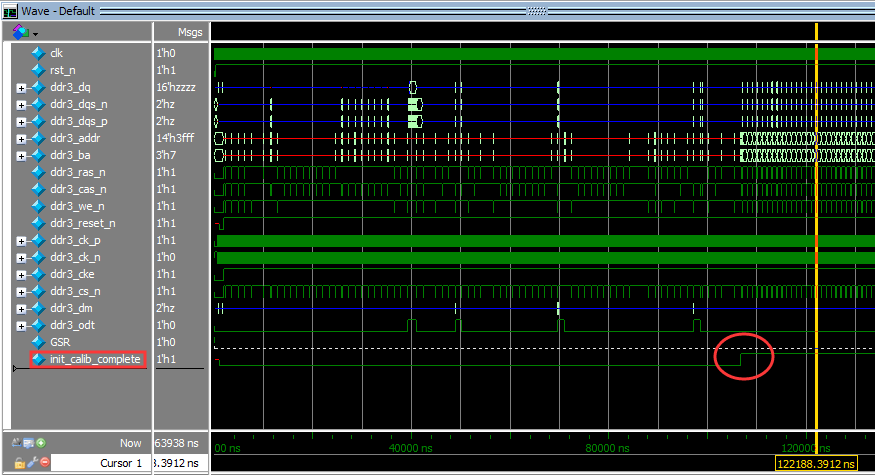
the above.
Reference: Wei-three FPGA Tutorial College